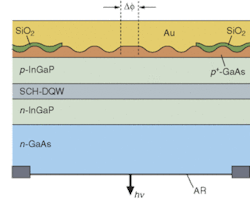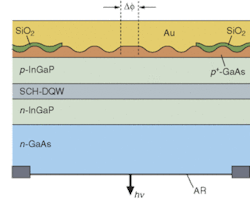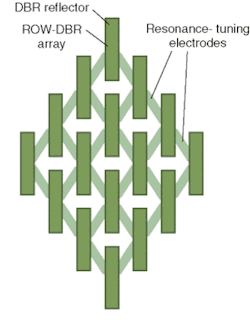Active-photonic-lattice distributed-feedback lasers emit a diffraction-limited surface-normal beam. These lasers can be coherently combined into arrays that could potentially emit 50 W of continuous-wave IR light.
High-power (greater than 0.5-W) continuous-wave laser diodes with high beam quality would be of great benefit to areas ranging from free-space and fiberoptic communications to micromachining. Today, high-power continuous-wave laser diodes exist in the form of diode arrays with output powers in the tens of watts, and single emitters having large aperture widths (on the order of 50 to 100 µm) with powers ranging to more than a watt. Neither of these configurations provides a high-quality (single-lateral-mode) beam.
A fundamental approach to achieving coherent power in stable, narrow beams is to use active photonic lattices (APLs), or photonic-lattice structures with spatially periodically modulated gain.1 Active photonic lattices can be incorporated into both edge-emitting and surface-emitting lasers. In the form of second-order distributed-feedback (DFB) gratings, APLs can enable surface-normal emission from monolithically fabricated laser diodes (no cleaved facets necessary).
Combining the DFB gratings with an APL-type structure in the lateral direction provides a two-dimensional (2-D) single-mode surface-emitting laser. Further, these lasers can be coherently coupled in 2-D arrays, all oscillating at the same frequency, resulting in an all-monolithic semiconductor structure emitting tens of watts into a coherent, surface-normal beam.
Active photonic lattices
A DFB laser is a photonic-bandgap APL structure. A second-order DFB device for surface emmission has on both ends distributed-Bragg-reflector (DBR) gratings that serve as mirrors. Thus a DFB/DBR grating can couple the laser light out of the plane of the laser's waveguide structure into free space, eliminating the need for cleaving of facets. Adding a half-wave (π) phase shift to the center of a second-order DFB grating allows a DFB laser to fundamentally favor lasing in a stable single-lobed, surface-normal beam (see Fig. 1).2 This is an important result, as such a beam is crucial to many laser applications.
In an one example of this device, a double-quantum-well indium gallium arsenide/indium gallium arsenide phosphide (InGaAs/InGaAsP) active region is fabricated with InGaP cladding layers; emission is at 980 nm. The outcoupling grating is the combination of a variable-thickness GaAs cap layer and gold deposited atop it. Thin layers of silicon dioxide (SiO2) between the gold and the GaAs define DBR regions. The π phase shift affects the outcoupled light but leaves the light within the cavity unaffected; thus, the π-phase-shift device is a defect-free (photonic-bandgap) APL structure.
The laser in this first example has a 550-µm-long DFB region and 600-µm-long DBR regions, resulting in a maximum external differential quantum efficiency as high as 76%. Because approximately 80% of the optical output goes into the central lobe, the effective external differential quantum efficiency is 60%.
In a second example of a π-phase-shift DFB laser, a double-quantum-well structure of InGaAs, aluminum gallium arsenide (AlGaAs) and InGaP incorporates a 500-µm-long GaAs/gold grating and emits at 964 nm.3 Lateral-mode control is achieved by a 2.5-µm-wide ridge waveguide. Surface emission is through an 80-µm-wide window stripe in the metallization on the substrate's n-side. The laser emits a surface-normal single-lobe beam with a full-width at half-maximum (FWHM) divergence of 0.046°, and operates in a single longitudinal mode with a 0.08-nm linewidth (FWHM). The laser has a slope efficiency of 0.17 W/A and a temperature dependence of 0.06 nm/°C.
Measurements were carried out on this laser in pulsed operation, with 200-ns pulses at a 1-kHz repetition rate. The laser was run at up to 170 mA (three times threshold) and approximately 18 mW, limited by heating caused by a high contact resistance. By using thinner titanium and platinum films above the
DBR regions, the threshold will be reduced and the efficiency increased.
ROW arrays
While a DFB surface-emitting laser that emits a surface-normal diffraction-limited beam can by itself be scaled to powers that VCSELs (vertical-cavity surface-emitting lasers) cannot achieve, even more exciting is the potential for combining many second-order DFB lasers into a coherently emitting array. To achieve this, a row of surface-emitting DFB lasers can be coupled together in an antiguided resonant-optical-waveguide (ROW) array structure (see Fig. 2).
An ROW is also an APL structure, but of the photonic-bandpass type that allows all array elements to equally couple to each other and, with proper design, to all radiate in phase. Here, the DFB grating serves an important function in addition to its feedback and light-outcoupling functions; because the grating is placed only in the array-element regions, it strongly selects lasing in the in-phase (array) mode. Phase-locking multiple DFB lasers together results in a device with a large 200 × 1500-µm emitting aperture. The structure is, in effect, a 2-D second-order APL device with no lattice defects.
In preliminary results, a 20-element ROW array has been fabricated (but without gratings), which shows an optical output of 0.8 W in a single, narrow beam at a wavelength of 980 nm. The combination of DFB gratings and the ROW array into a 2-D APL device is expected to reach 2 to 3 W of continuous-wave, single-mode optical power.
Because these ROW-array DFB.devices are expected to achieve diffraction-limited beam quality at output powers roughly three orders of magnitude higher than today's state-of-the-art surface emitters, they should enable exciting developments such as orders-of-magnitude increases in the sensitivity of many noninvasive medical diagnostics (for example, breath analysis to detect many vital-organ malfunctions), as well as blue-emitting lasers producing hundreds of milliwatts of light for laser-projection systems.
Wafer-scale arrays
It is possible to go one step further and create a coherently emitting structure of many individual 2-D ROW-array DFB lasers in a larger 2-D array, with all devices connected via resonant leaky-wave coupling (see Fig. 3).1 Because the ROW-array lasers are monolithically fabricated, this larger array would be constructed monolithically at the wafer level. To achieve this on a wafer, the lateral spacing between ROW-array units would have to be adjusted to correspond to an odd number of lateral wavelengths to ensure in-phase resonant leaky coupling between units.
An array of ROW-array units operating in phase could potentially produce up to 50 W of coherent optical power in the IR. Such an emitter could provide the light for high-efficiency, high-resolution nuclear-magnetic-resonance imaging with noble gases (see Laser Focus World, January 2003, p. 36).
ACKNOWLEDGMENT
This work is supported by NSF grant ECS-0200321.
REFERENCES
- D. Botez, Proc.SPIE 4993, 20 (2003).
- G. Witjaksono and D. Botez, Appl. Phys. Lett. 78, 4088 (2001).
- G. Witjaksono et al., Appl. Phys. Lett. 83, 5365 (2003).
DAN BOTEZ is Philip D. Reed Professor of electrical and computer engineering at the University of Wisconsin, 1415 Engineering Drive, Madison, WI 53706; e-mail: [email protected].



